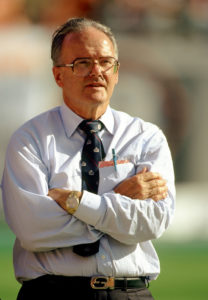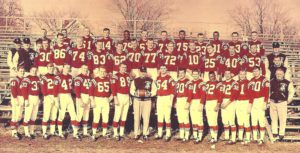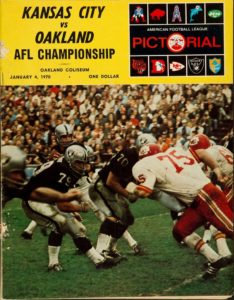
There’s an old adage in the business world: Don’t get mad, get even!
It was that sort of positive thinking from Texas oil millionaire Lamar Hunt that caused the formation of the most successful upstart professional sports league since MLB’s American league sprang on the scene in 1901. Editorial aside: now, if they would only get rid of the asinine designated hitter!
Hunt wanted a football franchise in his hometown of Dallas. He led a consortium that attempted to purchase the struggling Chicago Cardinals in 1958, with the idea of relocating them to Big D, but failed in his endeavor. Next, he tried to convince league commissioner Bert Bell that it was time for the NFL to get a couple of expansion teams, one, of course, being located in a certain north Texas city. Bell pooh-poohed the idea. Hunt’s dealings with the NFL were done.
On his plane back home from his ill-fated meeting, Hunt conceived the idea of a new football league. When the plane landed, he got on the phone to a few other movers and shakers and sketched out a plan for what would be the American Football League.
On August 14, 1959, the first league meeting was held. The first franchises were granted to Dallas, New York, Houston, Denver, Los Angeles, and Minneapolis-Saint Paul. That makes the AFL two weeks older than yours truly.
The NFL, wary of its upstart rival, immediately began wooing the owners of the new teams with promises of expansion franchises if they would just give up this silly new league idea. They managed to lure M-SP’s owner, but the rest stood firm. In an up-yours gesture aimed directly at Hunt, one of the new 1960 expansion teams was the Dallas Cowboys.

Two more franchises were granted to Detroit and Buffalo, and Oakland managed to grab up the vacancy left by the departure of the Minnesota team. Fortunately, the Senores soon decided to change their name to the Raiders.
The first AFL season took place in 1960. A few quality college players were signed up by team owners with large pocketbooks, and a five-year TV deal with perennial third-place network ABC, who was willing to gamble on the new league, made things pretty solid financially for the near future.
The first couple of years saw a lot of transition. An exhibition game took place in 1961 between the Buffalo Bills and the Hamilton Tiger Cats of the CFL. The Cats, one of the best in their league, beat the Bills, one of the worst in the AFL, but the Bills put up a respectable fight. That was the only meeting of its kind between the CFL and any American league.

In 1963, Hunt relocated the Dallas Texans to Kansas City and renamed them the Chiefs. There was simply no competing with the better-backed Cowboys in Dallas.
But the league continued to attract top talent away from the NFL via the draft, and that was what kept the public’s interest piqued. Additionally, the AFL had gained a reputation as a wide-open offensive affair, with lots of balls flying through the air. The NFL was known for lots and lots of boring running plays. Plus, the AFL had some innovative differences in rules from its senior rival: the two-point conversion, the scoreboard clock exactly matching the official clock (it wasn’t unusual in NFL games for the two clocks to vary by a few seconds), and putting player names on the backs of their jerseys. The league also reached out to black college athletes, who were still largely snubbed by the other guys.
The public grew more and more to love the irreverent league, and the NFL finally reluctantly reached out to them for a proposed merger. The talks began in 1966, but the deal wasn’t completed until 1970, shortly after Super Bowl 4 (I really hate those pretentious Roman numerals!). That particular game must have been deeply satisfying to Hunt, when his Kansas City Chiefs defeated the traitorous Minnesota Vikings.
Nowadays, there are still a few of the original AFL owners left, but they are getting up there. Hunt died in 2006. Buffalo’s Ralph Wilson is still around (update: passed in 2019), so is Oakland’s Al Davis (update: passed in 2011). The legacy of the AFL is seen in player’s names on the backs of ALL jerseys, the two-point conversion, and the dominance of the New England Patriots (watch out, Brady’s back!), as well as many other dynasties. So here’s a tip of the cap to the late Lamar Hunt, who decided to get even, and dreamed up the whole league on an airplane flight.